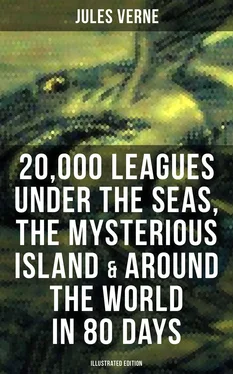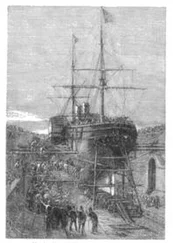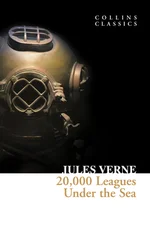Dillon returned to Calcutta. There he was able to interest the Asiatic Society and the East India Company in his discovery. A ship named after the Search was placed at his disposal, and he departed on January 23, 1827, accompanied by a French deputy.
This new Search, after putting in at several stops over the Pacific, dropped anchor before Vanikoro on July 7, 1827, in the same harbor of Vana where the Nautilus was currently floating.
There Dillon collected many relics of the shipwreck: iron utensils, anchors, eyelets from pulleys, swivel guns, an eighteen-pound shell, the remains of some astronomical instruments, a piece of sternrail, and a bronze bell bearing the inscription “Made by Bazin,” the foundry mark at Brest Arsenal around 1785. There could no longer be any doubt.
Finishing his investigations, Dillon stayed at the site of the casualty until the month of October. Then he left Vanikoro, headed toward New Zealand, dropped anchor at Calcutta on April 7, 1828, and returned to France, where he received a very cordial welcome from King Charles X.
But just then the renowned French explorer Captain Dumont d’Urville, unaware of Dillon’s activities, had already set sail to search elsewhere for the site of the shipwreck. In essence, a whaling vessel had reported that some medals and a Cross of St. Louis had been found in the hands of savages in the Louisiade Islands and New Caledonia.
So Captain Dumont d’Urville had put to sea in command of a vessel named after the Astrolabe, and just two months after Dillon had left Vanikoro, Dumont d’Urville dropped anchor before Hobart. There he heard about Dillon’s findings, and he further learned that a certain James Hobbs, chief officer on the Union out of Calcutta, had put to shore on an island located in latitude 8 degrees 18’ south and longitude 156 degrees 30’ east, and had noted the natives of those waterways making use of iron bars and red fabrics.
Pretty perplexed, Dumont d’Urville didn’t know if he should give credence to these reports, which had been carried in some of the less reliable newspapers; nevertheless, he decided to start on Dillon’s trail.
On February 10, 1828, the new Astrolabe hove before Tikopia Island, took on a guide and interpreter in the person of a deserter who had settled there, plied a course toward Vanikoro, raised it on February 12, sailed along its reefs until the 14th, and only on the 20th dropped anchor inside its barrier in the harbor of Vana.
On the 23rd, several officers circled the island and brought back some rubble of little importance. The natives, adopting a system of denial and evasion, refused to guide them to the site of the casualty. This rather shady conduct aroused the suspicion that the natives had mistreated the castaways; and in truth, the natives seemed afraid that Dumont d’Urville had come to avenge the Count de La Pérouse and his unfortunate companions.
But on the 26th, appeased with gifts and seeing that they didn’t need to fear any reprisals, the natives led the chief officer, Mr. Jacquinot, to the site of the shipwreck.
At this location, in three or four fathoms of water between the Paeu and Vana reefs, there lay some anchors, cannons, and ingots of iron and lead, all caked with limestone concretions. A launch and whaleboat from the new Astrolabe were steered to this locality, and after going to exhausting lengths, their crews managed to dredge up an anchor weighing 1,800 pounds, a cast-iron eight-pounder cannon, a lead ingot, and two copper swivel guns.
Questioning the natives, Captain Dumont d’Urville also learned that after La Pérouse’s two ships had miscarried on the island’s reefs, the count had built a smaller craft, only to go off and miscarry a second time. Where? Nobody knew.
The commander of the new Astrolabe then had a monument erected under a tuft of mangrove, in memory of the famous navigator and his companions. It was a simple quadrangular pyramid, set on a coral base, with no ironwork to tempt the natives’ avarice.
Then Dumont d’Urville tried to depart; but his crews were run down from the fevers raging on these unsanitary shores, and quite ill himself, he was unable to weigh anchor until March 17.
Meanwhile, fearing that Dumont d’Urville wasn’t abreast of Dillon’s activities, the French government sent a sloop of war to Vanikoro, the Bayonnaise under Commander Legoarant de Tromelin, who had been stationed on the American west coast. Dropping anchor before Vanikoro a few months after the new Astrolabe’s departure, the Bayonnaise didn’t find any additional evidence but verified that the savages hadn’t disturbed the memorial honoring the Count de La Pérouse.
This is the substance of the account I gave Captain Nemo.
“So,” he said to me, “the castaways built a third ship on Vanikoro Island, and to this day, nobody knows where it went and perished?”
“Nobody knows.”
Captain Nemo didn’t reply but signaled me to follow him to the main lounge. The Nautilus sank a few meters beneath the waves, and the panels opened.
I rushed to the window and saw crusts of coral: fungus coral, siphonula coral, alcyon coral, sea anemone from the genus Caryophylia, plus myriads of charming fish including greenfish, damselfish, sweepers, snappers, and squirrelfish; underneath this coral covering I detected some rubble the old dredges hadn’t been able to tear free— iron stirrups, anchors, cannons, shells, tackle from a capstan, a stempost, all objects hailing from the wrecked ships and now carpeted in moving flowers.
And as I stared at this desolate wreckage, Captain Nemo told me in a solemn voice:
“Commander La Pérouse set out on December 7, 1785, with his ships, the Compass and the Astrolabe. He dropped anchor first at Botany Bay, visited the Tonga Islands and New Caledonia, headed toward the Santa Cruz Islands, and put in at Nomuka, one of the islands in the Ha’apai group. Then his ships arrived at the unknown reefs of Vanikoro. Traveling in the lead, the Compass ran afoul of breakers on the southerly coast. The Astrolabe went to its rescue and also ran aground. The first ship was destroyed almost immediately. The second, stranded to leeward, held up for some days. The natives gave the castaways a fair enough welcome. The latter took up residence on the island and built a smaller craft with rubble from the two large ones. A few seamen stayed voluntarily in Vanikoro. The others, weak and ailing, set sail with the Count de La Pérouse. They headed to the Solomon Islands, and they perished with all hands on the westerly coast of the chief island in that group, between Cape Deception and Cape Satisfaction!”
“And how do you know all this?” I exclaimed.
“Here’s what I found at the very site of that final shipwreck!”
Captain Nemo showed me a tin box, stamped with the coat of arms of France and all corroded by salt water. He opened it and I saw a bundle of papers, yellowed but still legible.
They were the actual military orders given by France’s Minister of the Navy to Commander La Pérouse, with notes along the margin in the handwriting of King Louis XVI!
“Ah, what a splendid death for a seaman!” Captain Nemo then said. “A coral grave is a tranquil grave, and may Heaven grant that my companions and I rest in no other!”
CHAPTER 20
The Torres Strait
Table of Contents
DURING THE NIGHT of December 27-28, the Nautilus left the waterways of Vanikoro behind with extraordinary speed. Its heading was southwesterly, and in three days it had cleared the 750 leagues that separated La Pérouse’s islands from the southeastern tip of Papua.
On January 1, 1868, bright and early, Conseil joined me on the platform.
“Will master,” the gallant lad said to me, “allow me to wish him a happy new year?”
Читать дальше












